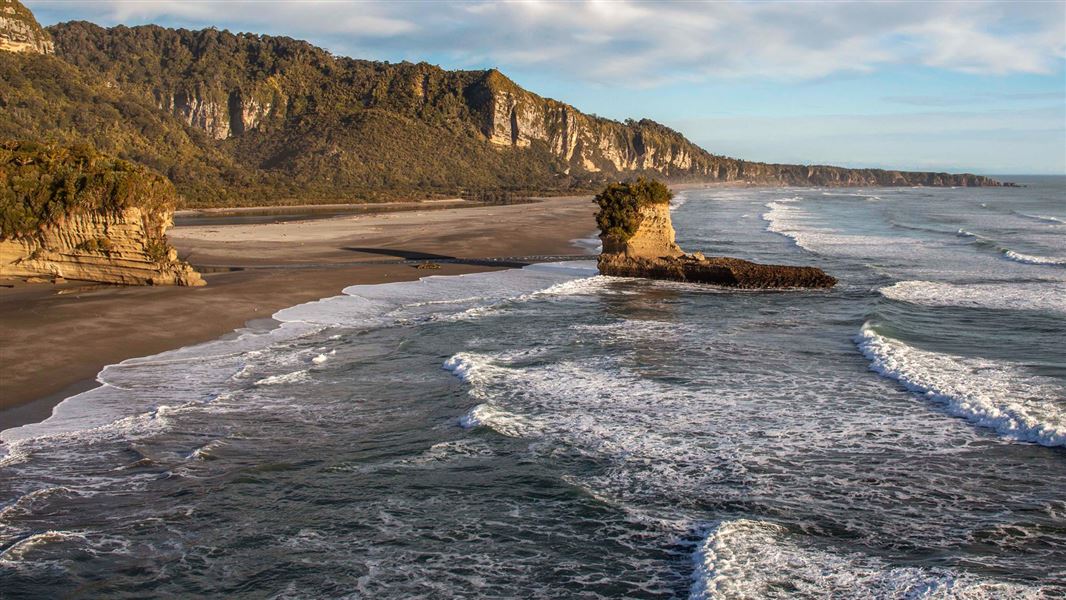The marine reserve was established in 2014 and is 3,520 hectares. It covers much of the coastline at the edge of Paparoa National Park.
Image gallery
Enjoy the Punakaiki Pancake Rocks and Blowholes Walk at Dolomite Point.
Truman Track includes a stunning walk through unspoiled subtropical forest to a spectacular coastline.
Follow State High 6 to access Punakaiki Pancake Rocks and Blowholes Walk at Dolomite Point.
Alternatively, nearby Truman Track allows visitors to access other areas within the reserve.
Be prepared
The weather on the West Coast can change quickly, so always carry:
- good wet weather gear
- warm clothes
- enough food and water.
Inform a responsible person of your plans and expected return time. Keep an eye on the weather and sea forecasts, and watch out for large waves when walking on the beach or rocky shore.
Fishing
Two areas within the reserve allow for eeling, whitebaiting, and recreational fishing at river mouths. Check the locations carefully, as all marine life within the reserve is protected.
Quad bikes and horses
Quad bikes and horses are permitted in the reserve, provided there is minimal disturbance to the site and riders comply with legal requirements. Remember this is a marine reserve designed to protect the nature of both the land and sand.
Collecting
You can collect stones (up to 256 mm in diameter), shells, driftwood, sand, and gravel by hand for recreational purposes, but only as much as you can carry in one trip with minimal disturbance to the site.
Pounamu (greenstone) can be collected by members of Ngāi Tahu Whanui or with permission from Te Rūnanga o Ngāi Tahu.
Gold Mining
Existing gold mining operations as of September 7, 2014, may continue if they remain the same in scale and extent and comply with all relevant legal requirements.
Farming
Farmers with land adjoining the reserve can drive cattle or sheep using dogs and operate motor vehicles on the foreshore, provided there is minimal disturbance to the reserve and compliance with legal requirements. This applies only to the part of the marine reserve south of a line extending west from the southern boundary of the coastal portion of the Punakaiki Scenic Reserve to a point at 42°14.74′S and 171°32.35′E.
View reserve maps and boundaries
Hibernia Creek
To open the outlet of Hibernia Creek, the owner or occupier of the adjoining land may use non-motorized hand-held tools and equipment such as front-end loaders and excavators.
Punakaiki Marine Reserve covers more than 35 square km from Perpendicular Point to near Maher Swamp, and out to two nautical miles from shore. Paparoa National Park and the marine reserve combined, protect heavily forested land and water catchments from the mountains out to sea.
The reserve surrounds Dolomite Point’s pancake rocks and blowholes, one of the most distinctive landscapes of the West Coast. The pancake rocks are 30 million year old limestone formations – the shells of ancient marine animals overlaid with soft mud and clay, raised by earthquakes and etched out by the sea.
The sea is still working on this natural sculpture, rasping through spectacular blowholes in the rocks.
Visitors to the rest of Punakaiki Marine Reserve will find a representative slice of wild West Coast life – rocky and gravel shores giving way to forests of bull kelp and other seaweeds, and vigorous waves rolling in from big, windswept seas.
On stormy days, plankton (microscopic floating plants and animals) are whipped up by the frenzied sea, washing up as a frothy band of sea foam that is sometimes a metre or more deep on the beach.
Westland petrels breed in the hills above Barrytown Flats, and are often seen in the reserve. Albatrosses, petrels, terns and gannets also pass through. Blue penguins and Hector’s dolphins can be seen within the reserve.
Offshore, beyond rocky reefs, the seabed is mostly a rippled surface of sand and mud that provides habitat for burrowing surf clams and worms, as well as fish like stargazers, gurnard and sharks. The driftwood-strewn cobble ridge beaches of the Barrytown flats are a feature of the central and northern West Coast.
Several rivers and creeks meet the sea at Punakaiki Marine Reserve, creating a variety of mouth formations that link to coastal streams and wetlands.
Pounamu (greenstone) can be collected by members of Ngāi Tahu Whanui or with permission from Te Rūnanga o Ngāi Tahu.
Protect our marine reserves
- No fishing of any kind.
- Don't take or kill marine life.
- Don't remove or disturb any marine life or materials.
- Don't feed fish - it disturbs their natural behaviour.
- Take care when anchoring to avoid damaging the sea floor.
No dogs allowed
To protect our native wildlife, dogs are not allowed anywhere in this place.
Paparoa National Park Visitor Centre
| Phone: | +64 3 731 1895 |
| Email: | paparoavc@doc.govt.nz |
| Address: | 4294 Coast Road Punakaiki RD 1 Runanga 7873 |
| Hours: | Visitor centre hours and services |
